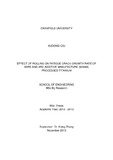JavaScript is disabled for your browser. Some features of this site may not work without it.
| dc.contributor.advisor | Zhang, Xiang | |
| dc.contributor.author | Qiu, Xundong | |
| dc.date.accessioned | 2014-05-09T13:12:57Z | |
| dc.date.available | 2014-05-09T13:12:57Z | |
| dc.date.issued | 2013-11 | |
| dc.identifier.uri | http://dspace.lib.cranfield.ac.uk/handle/1826/8441 | |
| dc.description.abstract | Titanium (Ti) alloys have been commonly used in the aerospace industry, not only because they have a high strength-to-weight ratio (comparing to the steels) but also their satisfactory corrosion resistance. Furthermore, they can be assembled with the carbon fibre composite parts. However, conventional manufacturing methods cause high material scrap rate and require lots of machining to obtain the final shape and size, which increases both the manufacturing time and cost. In order to improve the efficiency and reduce the cost of Ti parts, Additive Manufacturing (AM) has been developed. Rolled Wire and Arc Additive Manufacturing (rolled WAAM) is one of the AM processes. The main characteristics of this technology is the reduced β grain size to refine the alloy's microstructure. Both the ultimate tensile strength and yield strength of Ti alloy made by rolled WAAM are at least 10% higher than traditional wrought Ti. This project is to investigate the fatigue crack growth rates of the Ti-6Al-4V built by rolled WAAM process in both the longitudinal and transverse orientations to study the effect of rolling on fatigue crack growth rate of WAAM processed Ti. The project was carried out by testing the fatigue crack growth rates for 4 compact tension specimens. The test results of different orientations were compared with each other, and scatters in fatigue life and fatigue crack growth rate were found. Fatigue crack growth rate is lower in the longitudinal specimens. The results are also compared with those of the unrolled WAAM specimens tested in a previous project. It was found that rolling can significantly improve the fatigue crack growth behaviour in WAAM processed Ti, and can reduce the difference between the two orientations, i.e. achieving better isotropic material properties. Recorded scatters may be caused by the process induced residual stresses, error in measurement, and the test machine load range being much higher than the applied loads. More specimens can be tested to validate above observations further. | en_UK |
| dc.language.iso | en | en_UK |
| dc.publisher | Cranfield University | en_UK |
| dc.rights | © Cranfield University 2013. All rights reserved. No part of this publication may be reproduced without the written permission of the copyright owner. | en_UK |
| dc.subject | Additive Manufacturing | en_UK |
| dc.subject | Fatigue Crack Growth Rate | en_UK |
| dc.subject | Ti-6Al-4V | en_UK |
| dc.subject | Compact Tension Specimen | en_UK |
| dc.subject | Rolling | en_UK |
| dc.title | Effect of rolling on fatigue crack growth rate of Wire and Arc Additive Manufacture (WAAM) processed Titanium | en_UK |
| dc.type | Thesis or dissertation | en_UK |
| dc.type.qualificationlevel | Masters | en_UK |
| dc.type.qualificationname | MSc by Research | en_UK |
